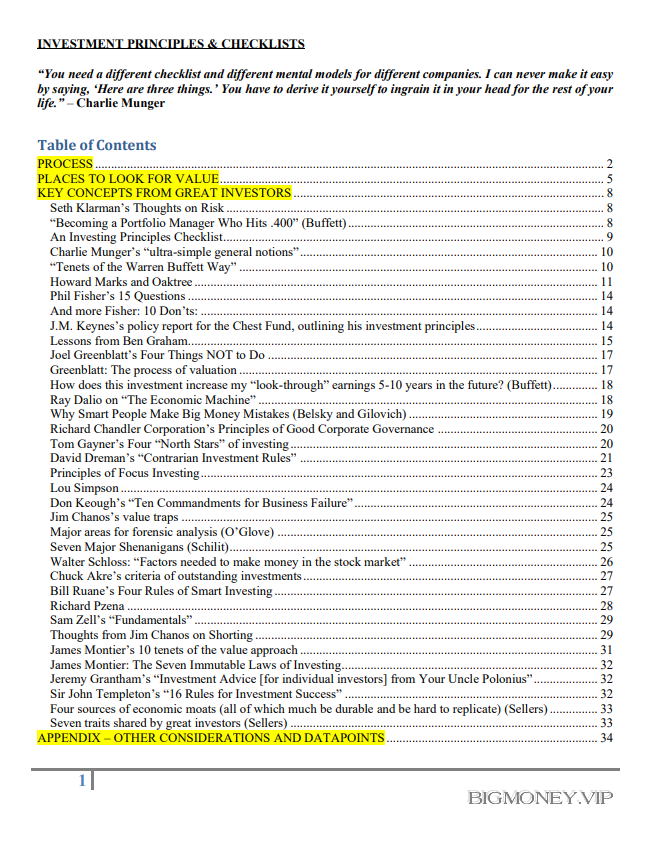INVESTMENT PRINCIPLES & CHECKLISTS

• Good checklists are precise, efficient, easy to use even under difficult conditions, do not try to spell out
everything, and provide reminders of only the most critical and important steps; the power of checklists
is limited
o Bad checklists are vague, imprecise, too long, hard to use, impractical, and try to spell out every
single step
• Do-confirm checklist: perform jobs/tasks from memory and experience, but then stop, run the checklist
and confirm that everything was done correctly
• Read-do checklist: carry out tasks as they are checked off – more like a recipe
PROCESS
Focus on original source documents, working from in to out
• SEC fillings
o Read 10-Qs, 10-Ks, proxies and other filings in reverse chronological order
• Press releases and earnings calls/transcripts
• Other public information
o Court documents, real estate records, etc.
• Industry publications
• Third-party analysts
o Sell-side research only as a consensus-checking exercise
• Research the company’s competitors with the same process
o Research and speak to competitors, (former) employees, and people in the supply chain
• Estimate valuation before looking at market valuation
o Valuation – What would a rational, long-term, private buyer would pay in cash today for the
entire business?
▪ Asset value
▪ Earning power
• if EP >NAV, then franchise value
▪ Growth value
• Requirements
o Large, well understood margin of safety
o Reinvestment opportunities for capital in the business
o Quality, ownership stake, and shareholder-orientation of management
o Ability to bear pain, both the company’s and my own
Munger’s “Four Filters”
• Understand the business
• Sustainable competitive advantages (aka, favorable long-term economics)
• Able and trustworthy management
• Price that affords a margin of safety (aka, a sensible purchase price)
Pause Points in the Process
➔ Always think in terms of Process + Patience
➔ How big is the margin of safety? How reliable is it? Why?
Pause #1
▪ Are the business and its securities able to be understood and valued?
o Avoid loss by
Pause #2
▪ Go back through all financial disclosure looking for information and context missed the first time
o Patterns/trends
▪ Level and quality of disclosure
o Specifics (see next section)
Pause #3 – final checks
▪ What can go wrong? Do a “pre-mortem”
▪ How can capital be permanently impaired by this investment?
▪ What are the probabilities? Are the odds heavily in my favor?
▪ What is the time horizon?
▪ How attractive is the opportunity? Namely, how attractive is compared to my best current
investment?
Munger’s “two-track analysis”
• First, lay out and deeply understand the rational factors that govern the situation under consideration
• Second, focus attention on psychological missteps – either your own or those of other investors
“The Most Important Things”
o Margin of safety
o Balance sheet
▪ Capital structure and liquidity
▪ Asset value
o Cash flow
▪ Realistic and reliable owner’s earnings (especially a few years from now)
▪ Can cash be reinvested at attractive compound rates?
▪ How has management allocated capital?
Initial ideas to consider in the process
1. Separate the business from the balance sheet
• How is the business capitalized? Is it sustainable? Is it relatively efficient/optimal?
• What are the assets worth? Liquidation value and reproduction value
• Are there any “hidden” assets or liabilities?
o Excess cash, real estate, LIFO, etc.
o Pension, legal liability, litigation, operational malfeasance, funding/liquidity puts, etc.
2. Separate the business from the cash flows




